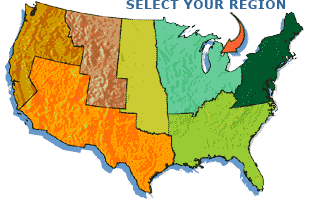Following Spring Migration
All across North America, one of the sure signs that spring is on the way is the return of the migratory birds.
 If you are familiar with the birds in your area you know that the change can be abrupt:
One morning, the bushes and trees around you are suddenly filled with singing birds that were not there just the day before.
They have arrived during the night, following a combination of celestial (by the stars) and magnetic cues that are part of their
genetic heritage.
If you are familiar with the birds in your area you know that the change can be abrupt:
One morning, the bushes and trees around you are suddenly filled with singing birds that were not there just the day before.
They have arrived during the night, following a combination of celestial (by the stars) and magnetic cues that are part of their
genetic heritage.
The most amazing part of this story is that these tiny birds may have flown thousands of miles to reach your yard, after spending the North American winter in Mexico, Central America, or South America, where the days remain warm and food is plentiful during our cold season.
Many of the birds we consider "our birds," those that appear in field guides to the United States, actually spend less than half of their lives here. They move north as the snow melts and raise young on the plentiful supplies of insects that are abundant only during the long warm days of our late spring and summer. At the end of the breeding season, usually in late summer or fall, they move south again, most of them following only their instincts to reach the traditional "winter" home of their species. This fall migration is a somewhat drawn-out process for many species, and flocks will linger and feed wherever food is available.
The spring migration, however, is urgent. For each species there is a specific, optimal time when the birds need to arrive in their breeding areas. The strongest males arrive first and stake out the prime territories, often in the same location where they nested the previous year. When females arrive, they select the males that occupy the best habitats for raising young. The pair must then construct a nest, incubate eggs, and raise their brood in the short period before it is time to start the journey back to the wintering range.
The maps that accompany this feature illustrate the timing of migration, showing the average arrival dates for 50 species of birds as they return to North America in spring. They are based on the observations of professional and amateur birders who monitored these arrivals over many years.
While there is a certain amount of variability each year, these long-term averages are revealing a disturbing trend. In the last 20 years, many species are arriving earlier, and a significant number of species are also shifting farther to the north. Why? Scientists now believe that climate change caused by the buildup of greenhouse gases is disrupting the timing of migration and sending some species farther north in search of insects.
In recent years there has been an alarming decline in the populations of many migratory bird species. This is a result of several converging factors. Species that depend on unbroken forests in their North American breeding range are suffering because of forest fragmentation. The same species face additional threats south of the U.S. border, where logging and slash-and-burn agriculture are rapidly destroying thousands of acres of their habitats each day. In recent years, much research has focused on the lives these birds lead during their stay to the south, looking at how they interact with nonmigratory resident species and how the habitat changes taking place in southern forests might affect the migrants. For each of the birds featured here, we have included some insights into the lives they lead while they are south of our border. We hope this gives you an even deeper appreciation for these tiny travelers, whose lives extend beyond the maps in our field guides.
 If you are familiar with the birds in your area you know that the change can be abrupt:
One morning, the bushes and trees around you are suddenly filled with singing birds that were not there just the day before.
They have arrived during the night, following a combination of celestial (by the stars) and magnetic cues that are part of their
genetic heritage.
If you are familiar with the birds in your area you know that the change can be abrupt:
One morning, the bushes and trees around you are suddenly filled with singing birds that were not there just the day before.
They have arrived during the night, following a combination of celestial (by the stars) and magnetic cues that are part of their
genetic heritage.

